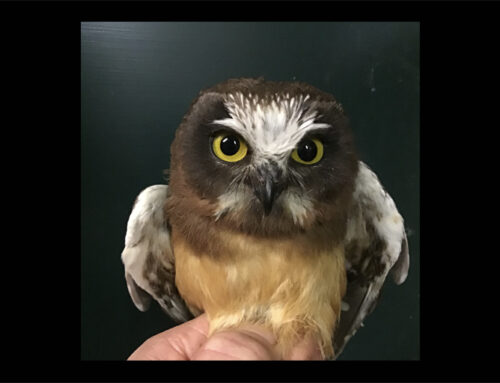It’s been another windy week here at the Point! Another stretch of strong winds kept nets closed several of the past few nights. We had been averaging over 50 new Northern Saw-whet Owl banded each of the first three weeks of the season. We didn’t quite make it this week, but we came close! At this point, we have caught a total of 206 owls: 199 Northern Saw-whet Owl (193 new and six recaptured birds from either a previous season or different owl banding station), two Long-eared Owl, and five Barred Owl.
One notable individual we saw this week was a young Northern Saw-whet Owl that still had almost completely juvenile plumage! It is not uncommon to catch a few owls that are still in the processes of molting in their adult body feathers (we’ve caught a few this season!), and this bird was no exception. That said, it is surprisingly late in the year to get a bird with such a high proportion of juvenile feathers.
We got some great questions about recaptures this week!
The vast majority of the owls we catch each year are birds that have never been caught before. We place an aluminum band on each owl’s leg and record data such as age, sex, and body condition. Each of these bands, issued by the Bird Banding Lab through USGS, has a unique nine-digit number that serves in a similar way as a driver’s license number, allowing that bird to be identified if it ever gets caught in the future either here at WPBO or another banding station.
Occasionally, we catch an owl that has previously been banded. Each of these birds is processed the same as a new bird except that we record the existing band number rather than adding a new one. The Bird Banding Lab manages the data submitted by banding stations around the country. Using that nine-digit identification number, we can learn where the bird was initially banded and some of the basic data recorded (e.g., how old it was). Recaptured birds can provide all sorts of important information! First, it gives us insight into where birds are going — one past WPBO recap was caught over 1,400 kilometers away! We can also keep track of how long birds live. For example, did you know that the oldest known wild Northern Saw-whet Owl was over nine years and five months old? (If you’re curious how long birds of other species live, you can check out the Bird Banding Lab’s Longevity Records.) If we catch a bird that was initially banded at WPBO, we can look back at our records to see how the data have changed.
So far this season, we have caught six previously banded birds. We know that four of these were banded at WPBO — three were banded as juveniles this summer by Chris Neri and Hannah Toutonghi, and two were banded at other stations. We haven’t learned where specifically, but we’ll let you know once we do!
-Kate Maley and Eliana Fierro-Calderón, fall owl banders
Please Note
Out of an abundance of caution and to help prevent the spread of COVID-19, public observation of owl banding is not available this season.
If you have questions about the owl banding program, please feel free to reach out through social media (Facebook, Instagram, or Twitter) or email [email protected].




